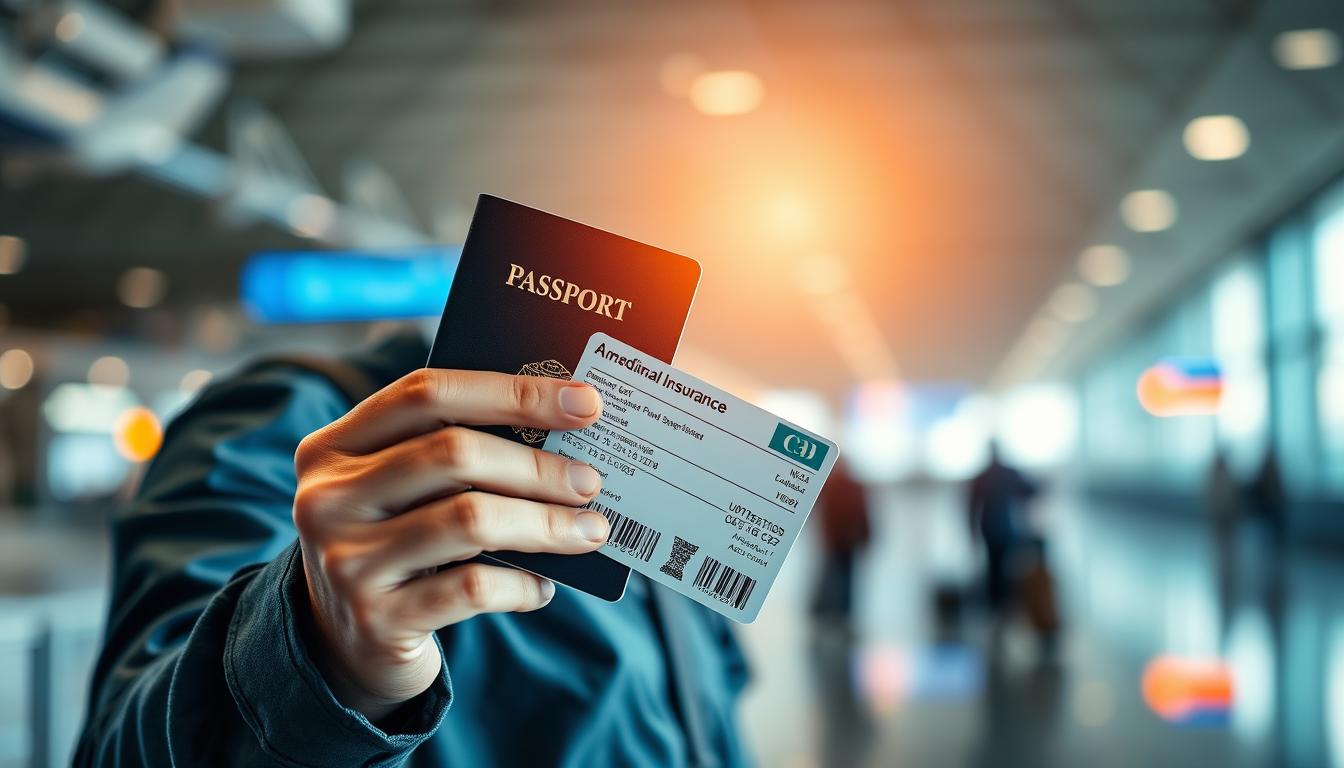Nothing derails an international trip faster than sudden tooth pain or a cracked crown. If you’ve ever wondered, “Will my insurance help if I need urgent care overseas?”, you’re not alone. Travelers often overlook dental mishaps when planning trips—until they’re scrambling to find a clinic in an unfamiliar country.
Many plans offer supplemental protection for unexpected issues like lost fillings or infections. These policies typically cover basics such as exams, X-rays, or extractions. However, benefits vary by plan type and location. For example, some insurers cap payouts per procedure or require pre-approval.
We’ll break down how these policies work alongside your regular health insurance. You’ll learn what’s included (and what’s not), how to choose the right plan, and why reading the fine print matters. Let’s ensure your next adventure stays on track—even if your teeth decide to rebel.
Understanding Coverage for Dental Emergencies
Imagine biting into a local delicacy and feeling a molar crack. Limited dental benefit plans act like safety nets for these moments. Unlike standard health policies, they focus solely on sudden problems like infections or broken crowns. For example, Aflac’s policies may cover X-rays or extractions but exclude routine cleanings.
What Limited Plans Offer
These insurance options prioritize speed over breadth. They’re designed to address urgent needs quickly, often requiring lower premiums. Key features include:
- Immediate care for sudden pain or trauma
- Fixed payouts per procedure (e.g., $150 for an exam)
- No waiting periods for eligible treatments
Gaps in Protection
Comprehensive health insurance usually ignores tooth-related problems unless they’re life-threatening. Limited plans fill this void but come with restrictions. Investopedia notes these policies might exclude pre-existing conditions or cap annual benefits at $1,000. Availability also varies—some states like New York have stricter regulations.
Always verify your policy’s fine print before traveling. A quick call to your agent can clarify what’s included and where you’ll find in-network providers. This step ensures you get help soon possible if trouble strikes mid-journey.
When Dental Emergencies Occur Abroad
You’re sipping coffee in Paris when a sharp jolt shoots through your jaw. Dental issues don’t care about your itinerary—they strike when least expected. Knowing how to spot urgent problems versus manageable discomfort can save your trip (and your smile).
Recognizing Life-Threatening and Urgent Conditions
Severe infections or trauma demand immediate action. The ADA warns that swelling affecting breathing or swallowing could signal a dangerous abscess. Similarly, knocked-out teeth from falls or accidents need professional care within 1-2 hours for possible reattachment.
Watch for these red flags:
- Uncontrolled bleeding from the mouth
- Fever paired with throbbing tooth pain
- Visible cracks exposing sensitive nerves
Common Dental Problems While Traveling
Most travelers face temporary annoyances like lost fillings or gum irritation from unfamiliar foods. While these hurt, they rarely require ER visits. Verywell Health suggests rinsing with saltwater and using temporary dental cement from pharmacies until you see a dentist.
Track pain patterns. Dull aches that worsen when lying down often indicate infections. Sudden sensitivity to hot/cold might mean enamel damage. Don’t tough it out—local dental clinics can usually resolve these faster than hospitals.
How Dental Insurance Plans Support Emergency Dental Care
Picture this: You’re hiking in the Andes when a toothache turns into unbearable pain. Without proper insurance, you’re left navigating foreign clinics and payment terms alone. Many travelers don’t realize their standard health plan often excludes urgent tooth-related care abroad—but specialized policies step in here.
Benefits and Exclusions Explained
Emergency-focused plans like Aflac’s offer direct payments for sudden problems such as abscesses or broken teeth. These typically cover exams, X-rays, or extractions at local clinics. However, CareCredit notes that hospital visits for trauma may only get partial reimbursement unless your policy specifies otherwise.
Common exclusions include:
- Pre-existing conditions diagnosed before your trip
- Cosmetic fixes like veneer replacements
- Routine cleanings or checkups
Comparing Supplemental vs. Primary Dental Coverage
Your regular health insurance might ignore tooth pain unless it’s life-threatening. Supplemental plans fill this gap but often have annual limits—Aflac caps some benefits at $1,000 per issue. Primary dental policies focus on domestic care, while travel-focused options prioritize immediate solutions abroad.
Always compare:
- Out-of-pocket costs for emergency procedures
- Network restrictions (local vs. international providers)
- Claim submission processes while overseas
One traveler learned the hard way: Their plan covered 80% of a root canal in Spain but required upfront payment. Knowing these details prevents financial shocks when you’re already stressed.
Key Considerations for Choosing a Dental Insurance Plan Abroad
Choosing the right protection for your smile abroad starts with smart prep work. Not all policies work the same way—especially when crossing state lines or oceans. Let’s simplify your search with practical steps tailored to globetrotters and families.

State-Specific Rules Matter
Did you know Aflac’s plans aren’t available in every state? New York residents, for example, face stricter regulations. Always verify if your policy works both at home and overseas. Some insurers offer riders for international trips, but these often require extra steps to activate.
Timing and Fine Print Checks
Waiting periods can leave you stranded. One traveler learned their plan required a 6-month delay before treating an infected mouth. Review these details early:
- Annual benefit caps (often $1,000-$1,500)
- Exclusions for pre-existing mouth conditions
- Reimbursement rules for infections or sudden pain
Families should confirm pediatric care options. A good life insurance company might bundle dental riders with travel policies, but compare costs. Ask: “Does this cover my teen’s wisdom tooth flare-up in Tokyo?”
Finally, test the claims process. Can you file online from Morocco? Does the insurer partner with clinics near your destinations? These steps prevent panic when you need emergency dental help far from home.
Steps to Take During a Dental Emergency Abroad
That crunch you hear while savoring street food isn’t always a sesame seed. Chipped broken teeth rank among the most common dental emergencies travelers face. Acting quickly can prevent infections and save your smile—here’s how to handle it like a pro.
Immediate First Aid and Preparation
If you crack a tooth, rinse your mouth with warm saltwater to clean the area. Save any fragments in milk or saline solution—they might be reattachable. For pain, take ibuprofen and apply a cold compress to reduce swelling. Avoid eating something hard or chewy until a professional assesses the damage.
Pack a mini dental kit with temporary cement, gauze, and your insurer’s contact info. As Verywell Health advises, this prep work lets you manage sudden issues while finding local care.
Knowing When to Visit a Dentist or Hospital
Persistent bleeding or throbbing pain means you need seen immediately. Dentists can often address chips or lost fillings same-day. However, head to a hospital if swelling affects breathing or you suspect a jaw fracture.
Keep broken pieces dry and avoid touching the tooth’s root. Contact your insurer while en route—many require pre-approval for non-life-threatening cases. With proper care, even serious issues can be resolved swiftly, letting you get back to your adventure.
Comparing Emergency Dental Care Options Abroad
Midway through your Tokyo food tour, a sharp pain erupts in your mouth—now what? Understanding where to seek care during a crisis can save time, money, and stress. Let’s explore your options when every minute counts.
Hospital Emergency Rooms Versus Local Dentists
Hospital ERs handle severe trauma like jaw fractures or uncontrolled bleeding. Verywell Health notes they’re equipped for life-threatening issues but often lack specialized dental tools. Wait times can stretch for hours, and costs may soar without proper insurance.
Local dental clinics excel at quick fixes for common problems. CareCredit reports they’re ideal for:
- Same-day appointments for cracked teeth
- Temporary fillings or pain relief
- Lower out-of-pocket fees compared to ERs
| Factor | Emergency Room | Local Dentist |
|---|---|---|
| Average Cost* | $500–$1,200 | $150–$400 |
| Wait Time | 2–6 hours | Under 1 hour |
| Insurance Support | Some dental insurance plans help cover 50–70% | 80–100% coverage common |
*Data sourced from Verywell Health & CareCredit
Travelers with life insurance policies should check for dental riders—some companies offer supplemental protection abroad. For non-critical issues like lost crowns, clinics provide faster, cheaper solutions. However, always contact your insurance company first. One traveler saved $800 by confirming their plan’s ER reimbursement rules before visiting a Madrid hospital.
When in doubt, start with a local dentist. They’ll direct you to hospitals if needed—keeping your journey (and budget) intact.
Expert Insights from Trusted Sources
What happens when your dream vacation collides with a dental disaster? Leading authorities like Investopedia and Verywell Health offer actionable strategies to navigate these crises. Their collective wisdom helps individuals and families make informed choices before unexpected issues arise.
Insurance Strategies from Industry Leaders
Investopedia stresses evaluating annual limits and network restrictions. “Look for policies covering at least 80% of common procedures abroad,” they advise. For example, CareCredit reports a root canal overseas averages $400-$1,200—far less than U.S. costs if your plan offers negotiated rates.
Verywell Health emphasizes prevention: “Contact your dentist at the first sign of swelling or sensitivity. Delaying care often turns minor dental problems into complex injuries.” They note 34% of travelers with dental injuries waited too long, needing pricier treatments.
Cost Realities for Common Procedures
CareCredit’s data reveals stark contrasts in pricing. A tooth extraction abroad ranges from $75-$300, while denture adjustments cost $100-$500. Compare this table showing U.S. vs. international averages:
| Procedure | U.S. Cost | Abroad Cost |
|---|---|---|
| Root Canal | $900-$1,500 | $400-$1,200 |
| Tooth Extraction | $150-$650 | $75-$300 |
| Temporary Crown | $1,000-$1,500 | $200-$600 |
Health insurance rarely bridges these gaps. As CareCredit notes, “Only 12% of standard health plans include non-emergency dental care overseas.” Supplemental policies often prove vital for families exploring remote areas.
New Mouth adds that prompt action saves money. A $150 filling today prevents a $1,200 root canal tomorrow. Whether you’re backpacking or beachside, keeping your insurer’s contact info handy ensures quick solutions when dental problems strike.
Conclusion
Picture unwinding on a Bali beach when sharp pain pierces your jaw. Understanding your protection options transforms panic into calm action. Limited plans bridge gaps left by standard health insurance, offering swift solutions for sudden issues like cracked teeth or infections. But they’re not universal fixes—annual caps and exclusions apply.
Act fast if you face trauma or swelling. Rinse with saltwater, save broken pieces, and contact your insurer immediately. While most common dental issues don’t require an emergency room, recognize when hospitals become necessary: breathing difficulties or uncontrolled bleeding demand urgent care.
Review your plan’s fine print before departure. Does it address types dental clinics abroad accept? Can you file claims remotely? One traveler avoided $1,200 in costs by confirming their policy covered same-day extractions in Costa Rica.
Stay prepared. Pack a mini dental kit and your insurer’s contact details. With smart prep and clear knowledge, you’ll handle surprises confidently—whether choosing a local clinic or tackling critical illness scenarios. Your next adventure deserves protection that lets you smile through any storm.
FAQ
What qualifies as a dental emergency while traveling abroad?
Does travel health insurance cover dental emergencies the same as medical ones?
FAQ
What qualifies as a dental emergency while traveling abroad?
Severe pain, uncontrolled bleeding, infections like abscesses, or trauma causing broken or knocked-out teeth are urgent issues. These require immediate care to prevent complications. Always contact a local dentist or hospital if you’re unsure.
Does travel health insurance cover dental emergencies the same as medical ones?
Most standard health insurance plans exclude non-life-threatening dental care. Supplemental dental policies like Delta Dental or Cigna’s international plans often have specific caps (e.g.,
FAQ
What qualifies as a dental emergency while traveling abroad?
Severe pain, uncontrolled bleeding, infections like abscesses, or trauma causing broken or knocked-out teeth are urgent issues. These require immediate care to prevent complications. Always contact a local dentist or hospital if you’re unsure.
Does travel health insurance cover dental emergencies the same as medical ones?
Most standard health insurance plans exclude non-life-threatening dental care. Supplemental dental policies like Delta Dental or Cigna’s international plans often have specific caps (e.g., $1,000 per incident) and may exclude pre-existing conditions.
Can I use my U.S. dental insurance abroad?
Some plans, like MetLife’s Global Coverage, offer limited international benefits. However, many require upfront payment, so save receipts for reimbursement. Always check your policy’s network providers through apps like Aetna International before traveling.
Will my plan cover root canals or extractions overseas?
It depends on your policy. For example, Guardian’s Dental Accident Insurance covers trauma-related procedures, while routine treatments may require a waiting period. Review exclusions for cosmetic work or pre-existing pain.
What should I do first during a dental emergency abroad?
Rinse your mouth with warm saltwater, save any broken tooth fragments, and use cold compresses for swelling. Apps like Dentista Near Me or your embassy’s website can help locate English-speaking dentists. Contact your insurer’s 24/7 hotline for guidance.
Are hospital ERs better than local dentists for dental issues?
ERs handle life-threatening trauma but lack specialized tools for fillings or crowns. Clinics like Aspen Dental abroad often provide faster, cheaper care. Note that insurance may not cover ER visits for non-critical issues like toothaches.
How do I choose the right dental insurance for international trips?
Look for policies like GeoBlue or Allianz Travel that include emergency dental, low deductibles, and direct billing. Check if they cover follow-up care at home and exclude high-risk activities like skiing injuries.
What if I can’t afford emergency dental care overseas?
Clinics in countries like Mexico or Thailand often offer lower costs. Services like CareCredit provide short-term financing, while organizations like International SOS assist with cashless payments if your insurer partners with them.
,000 per incident) and may exclude pre-existing conditions.
Can I use my U.S. dental insurance abroad?
Some plans, like MetLife’s Global Coverage, offer limited international benefits. However, many require upfront payment, so save receipts for reimbursement. Always check your policy’s network providers through apps like Aetna International before traveling.
Will my plan cover root canals or extractions overseas?
It depends on your policy. For example, Guardian’s Dental Accident Insurance covers trauma-related procedures, while routine treatments may require a waiting period. Review exclusions for cosmetic work or pre-existing pain.
What should I do first during a dental emergency abroad?
Rinse your mouth with warm saltwater, save any broken tooth fragments, and use cold compresses for swelling. Apps like Dentista Near Me or your embassy’s website can help locate English-speaking dentists. Contact your insurer’s 24/7 hotline for guidance.
Are hospital ERs better than local dentists for dental issues?
ERs handle life-threatening trauma but lack specialized tools for fillings or crowns. Clinics like Aspen Dental abroad often provide faster, cheaper care. Note that insurance may not cover ER visits for non-critical issues like toothaches.
How do I choose the right dental insurance for international trips?
Look for policies like GeoBlue or Allianz Travel that include emergency dental, low deductibles, and direct billing. Check if they cover follow-up care at home and exclude high-risk activities like skiing injuries.
What if I can’t afford emergency dental care overseas?
Clinics in countries like Mexico or Thailand often offer lower costs. Services like CareCredit provide short-term financing, while organizations like International SOS assist with cashless payments if your insurer partners with them.


